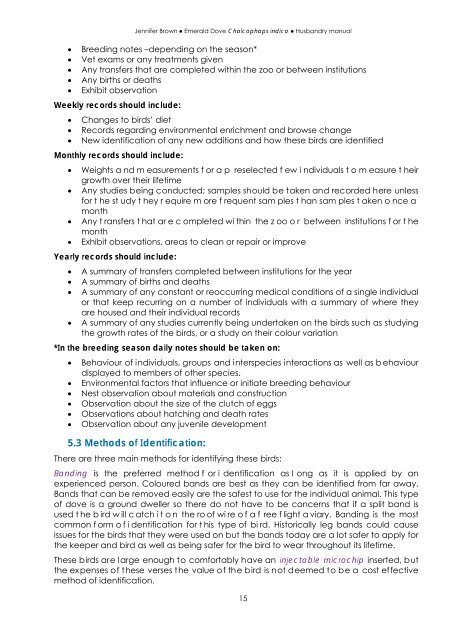Emerald Dove Husbandry Manual - Nswfmpa.org
Emerald Dove Husbandry Manual - Nswfmpa.org
Emerald Dove Husbandry Manual - Nswfmpa.org
You also want an ePaper? Increase the reach of your titles
YUMPU automatically turns print PDFs into web optimized ePapers that Google loves.
Jennifer Brown ● <strong>Emerald</strong> <strong>Dove</strong> Chalcophaps indica ● <strong>Husbandry</strong> manual<br />
• Breeding notes –depending on the season*<br />
• Vet exams or any treatments given<br />
• Any transfers that are completed within the zoo or between institutions<br />
• Any births or deaths<br />
• Exhibit observation<br />
Weekly records should include:<br />
• Changes to birds’ diet<br />
• Records regarding environmental enrichment and browse change<br />
• New identification of any new additions and how these birds are identified<br />
Monthly records should include:<br />
• Weights a nd m easurements f or a p reselected f ew i ndividuals t o m easure t heir<br />
growth over their lifetime<br />
• Any studies being conducted; samples should be taken and recorded here unless<br />
for t he st udy t hey r equire m ore f requent sam ples t han sam ples t aken o nce a<br />
month<br />
• Any t ransfers t hat ar e c ompleted wi thin the z oo o r between institutions f or t he<br />
month<br />
• Exhibit observations, areas to clean or repair or improve<br />
Yearly records should include:<br />
• A summary of transfers completed between institutions for the year<br />
• A summary of births and deaths<br />
• A summary of any constant or reoccurring medical conditions of a single individual<br />
or that keep recurring on a number of individuals with a summary of where they<br />
are housed and their individual records<br />
• A summary of any studies currently being undertaken on the birds such as studying<br />
the growth rates of the birds, or a study on their colour variation<br />
*In the breeding season daily notes should be taken on:<br />
• Behaviour of individuals, groups and interspecies interactions as well as b ehaviour<br />
displayed to members of other species.<br />
• Environmental factors that influence or initiate breeding behaviour<br />
• Nest observation about materials and construction<br />
• Observation about the size of the clutch of eggs<br />
• Observations about hatching and death rates<br />
• Observation about any juvenile development<br />
5.3 Methods of Identification:<br />
There are three main methods for identifying these birds:<br />
Banding is the preferred method f or i dentification as l ong as it is applied by an<br />
experienced person. Coloured bands are best as they can be identified from far away.<br />
Bands that can be removed easily are the safest to use for the individual animal. This type<br />
of dove is a ground dweller so there do not have to be concerns that if a split band is<br />
used t he b ird w ill c atch i t o n the ro of wi re o f a f ree f light a viary. Banding is the most<br />
common f orm o f i dentification for t his type of bi rd. Historically leg bands could cause<br />
issues for the birds that they were used on but the bands today are a lot safer to apply for<br />
the keeper and bird as well as being safer for the bird to wear throughout its lifetime.<br />
These birds are large enough to comfortably have an injectable microchip inserted, but<br />
the expenses of these verses the value of the bird is not deemed to be a cost effective<br />
method of identification.<br />
15

















